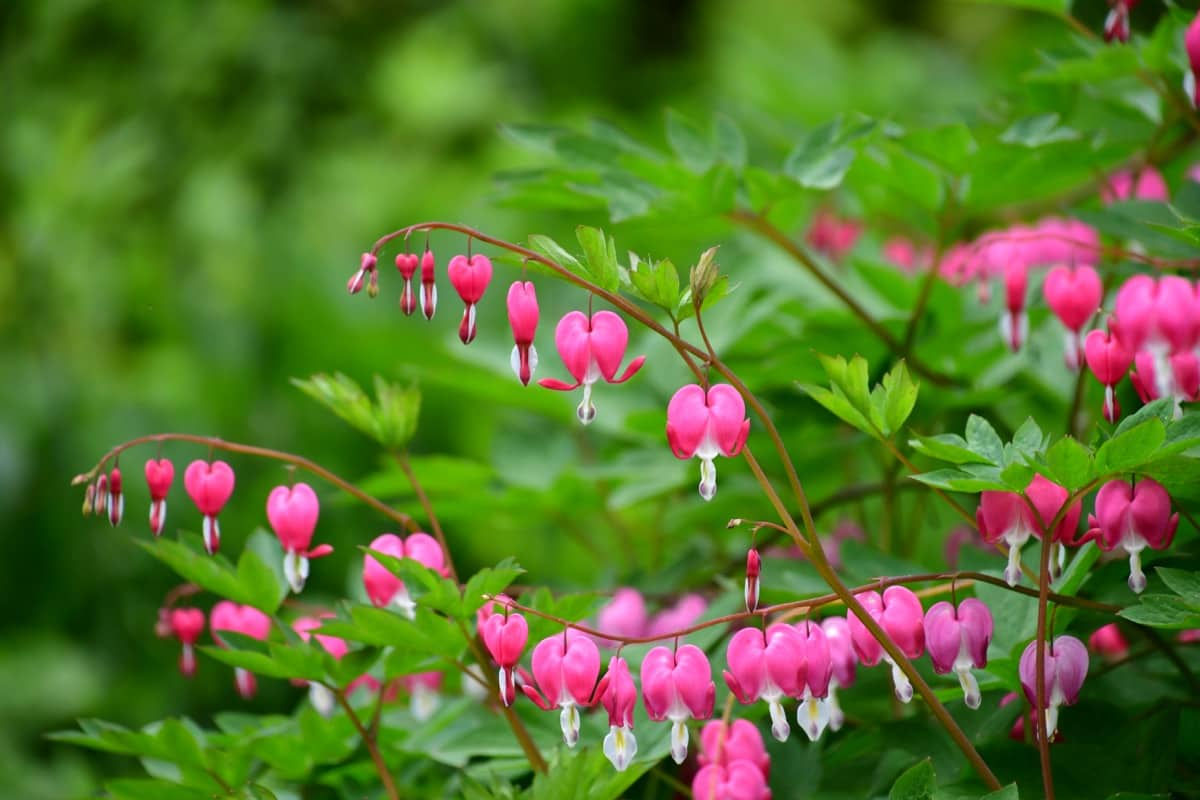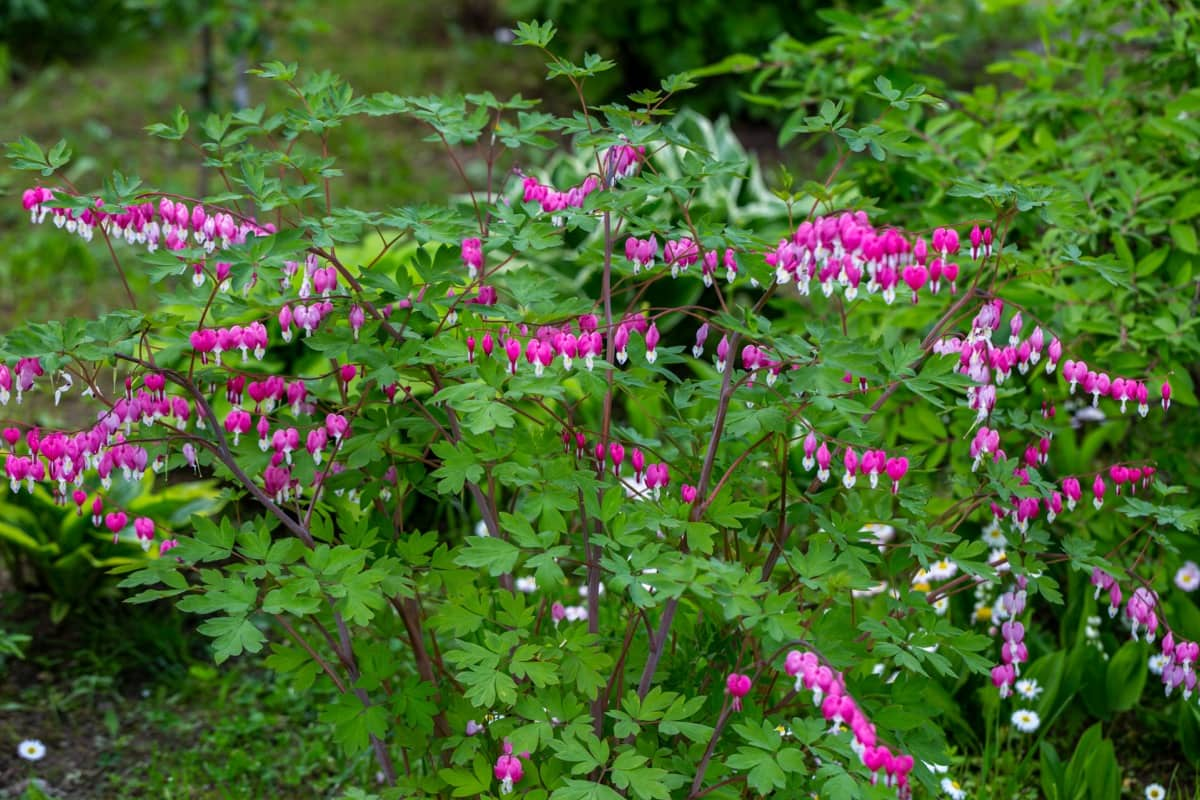The Bleeding Heart plant, known for its distinctive heart-shaped flowers that appear to “bleed” droplets of color, is popular for gardeners due to its visual appeal and relatively simple care needs. This charming plant, however, can sometimes present challenges, which, if left unaddressed, can cause harm to its health and appearance. Understanding and identifying the ten most common problems affecting the Bleeding Heart plant, along with their corresponding treatments and solutions, is crucial for gardeners and plant enthusiasts.

10 Bleeding Heart Plant Problems
First Major Issue: Loss of Leaves
The first problem, often evidenced by the Bleeding heart vine losing leaves, typically indicates a stressful condition for the plant. This could result from several factors, including inadequate watering, insufficient nutrients, or even a disease. When your Bleeding heart starts to lose its leaves, it’s a sign that the plant is not receiving the care it needs.
The best solution is to provide a steady water supply without over-saturating the plant and ensuring it has the nutrients it needs by regularly adding organic compost to the soil. If a disease is suspected, it may be necessary to use a fungicide or other treatment, but it’s important to diagnose the exact issue before proceeding.
Second Major Issue: Bloom Timing
Another common concern among gardeners is understanding when Bleeding hearts bloom. The Bleeding heart typically blooms in the spring, presenting an array of beautiful, heart-shaped flowers that can bring any garden to life. However, if your plant is not blooming when expected, it may be due to environmental factors such as insufficient light, over- or under-watering, or soil nutrient deficiencies. Ensuring your plant has the right water, sunlight, and nutrient balance will help it bloom during its expected season.
Third Major Issue: Yellowing Leaves
The third issue revolves around the coloration of the plant’s leaves. Specifically, a Bleeding heart leaves turning yellow signals that something is wrong. This is typically a symptom of overwatering, but it could also indicate a nutrient deficiency. To solve this issue, it’s crucial to change your watering routine and ensure the plant isn’t submerged in water, as it can cause root decay. Furthermore, adding nutrient-rich compost to the soil might be necessary to restore its health.
Fourth Major Issue: Curling Leaves
Bleeding heart leaves curling is the fourth problem that can be encountered. Curling leaves often indicate a lack of water or exposure to too much direct sunlight. Bleeding hearts prefer a shady spot in the garden, so placing them in an area with intense, direct sunlight can lead to a leaf curl. To solve this problem, ensure your plant receives adequate water and is positioned in a shaded garden area.
Fifth Major Issue: Plant Spread
The next common question among gardeners revolves around the plant’s spreading habit. Specifically, do Bleeding hearts spread? The answer is yes, they do. The Bleeding heart plant can spread by self-seeding or the growth of its rhizomatous roots. This spreading can become problematic if it overtakes other plants in the garden. The solution is to regularly monitor the plant’s spread and, if necessary, trim back the growth to keep it in check.
In case you missed it: How to Plant and Care for Bleeding Hearts: Flower Growing Instructions

Sixth Major Issue: Sun or Shade Preference
Understanding the Bleeding heart’s preference for sun or shade is crucial to its health and growth. Bleeding hearts usually like shade to avoid excessive sunlight, which can make the plant droop and its leaves become curled or yellow. However, the plant also requires some sunlight to flourish and produce blooms. To balance the Bleeding Heart’s sun and shade requirements, plant it in an area with filtered sunlight or partial shade. This will ensure that it gets the sunlight it needs without being overwhelmed by the intensity of the full sun.
Seventh Major Issue: Plant Toxicity
It’s also important to understand the plant’s toxicity when cultivating a Bleeding heart. Is the Bleeding heart poisonous? The answer is yes. Plant parts have alkaloids that can be dangerous if eaten by people or pets. Symptoms can include nausea, vomiting, dizziness, and even seizures in severe cases. The solution is to plant the Bleeding heart in a part of the garden that is out of reach of children and pets and to handle it with care, ideally while wearing gloves.
Eighth Major Issue: Soil Preferences
Understanding the type of soil the Bleeding heart plant prefers can significantly affect its health and vitality. Bleeding hearts favor well-draining soil that is rich in organic matter. They do not do well in soil that is overly sandy or clayey. Improve your struggling plant’s soil by adding compost or organic matter to enhance its texture and nutrient levels. You may also need to consider relocating the plant if the soil in its current location is not ideal.
Ninth Major Issue: Disease Problems
Several diseases can affect the health of a Bleeding heart plant, such as leaf spot and root rot. These can manifest in various ways, including yellowing or browning leaves, wilting stems, and a general plant appearance decline. If a disease is suspected, the solution may be to remove the plant’s affected parts or treat the plant with a suitable fungicide. It’s always advisable to accurately diagnose the disease before starting any treatment to ensure it is effective.
Tenth Major Issue: Pest Problems
Finally, pests such as aphids, slugs, and snails can also cause problems for the Bleeding heart plant. These pests harm plant leaves, stems, and hinder its growth. If a pest problem is identified, consider using a natural pesticide or encouraging natural predators into your garden. Regularly monitoring your plants and acting at the first sign of pests can keep them from becoming a significant problem.
In case you missed it: Discover the 10 Most Popular Ornamental Chicken Breeds for your Backyard

Conclusion
In summary, the Bleeding Heart plant is a beautiful garden addition, but it requires specific care for its well-being and longevity. These problems and their solutions revolve around understanding the plant’s preferences for light, water, soil, and location and its potential risks relating to toxicity and disease. With this knowledge, gardeners can help their Bleeding hearts flourish and enjoy their captivating blooms for many years.
- Feed Your Flock for Less: Top 10 Tips to Save on Chicken Feed
- Ultimate Guide to Ossabaw Island Hog: Breeding, Raising, Diet, and Care
- Hatching Answers: The Top 10 Reasons Your Chickens Aren’t Laying Eggs
- Eggs and Economics: Breaking Down the Cost of Raising Backyard Chickens
- Defend Your Greens: Proven Methods to Keep Iguanas Out of Your Garden
- Ultimate Guide to Cinnamon Queen Chicken: A Comprehensive Guide for Beginners
- Ultimate Guide to California Tan Chicken: Breeding, Raising, Diet, Egg-Production and Care
- Ultimate Guide to Marsh Daisy Chicken: Breeding, Raising, Diet, and Care
- 10 Types of Chicken Farming Businesses You Can Start for Profits